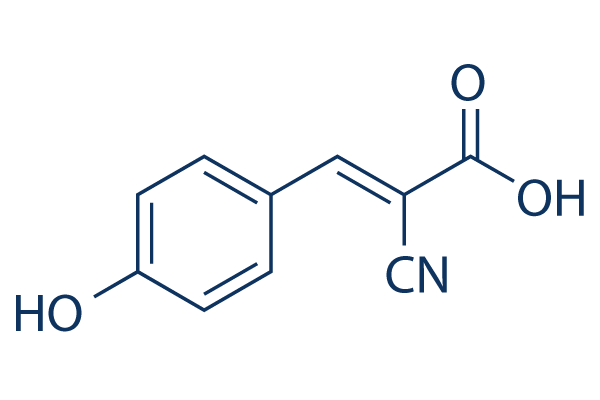| Cas No.: | 28166-41-8 |
| SMILES: | O=C(O)/C(C#N)=C/C1=CC=C(O)C=C1 |
| Formula: | C10H7NO3 |
| M.Wt: | 189.17 |
| Purity: | >98% |
| Sotrage: | 2 years -20°C Powder, 2 weeks 4°C in DMSO, 6 months -80°C in DMSO |
| Description: | In vitro: Most glioma cell lines are sensitive to CHC, with the exception of SW1088 and SW1783 cells, which show lower sensitivity. The effect of CHC on U251 and SW1088 total cell biomass appears to be related to lactate transport activity. Accordingly, U251 cells presents higher levels of MCT1 and CD147 at the plasma membrane than did SW1088, and consequently, CHC decreases glucose consumption and lactate production in U251, but not in SW1088 cells. In the sensitive U251 cells, CHC is able to inhibit cell proliferation and induce cell death, having a cytotoxic effect; however, in the less sensitive SW1088 cells, CHC only inhibits cell proliferation but did not induce cell death, having only a cytostatic effect. CHC does not enter the cell because its inhibitory effect is dependent on interactions with membrane proteins accessible from the outside of the cell. CHC can inhibit different MCT isoforms. However, they have different sensitivities. In this context, in addition to MCT1, CHC could also inhibit MCT4 activity; however, the latter should happen at much higher concentrations, because MCT4 has much lower affinity for CHC (Ki values are 5-10 times higher than for MCT1; 50-100 mM). Transport by MCT1, 2, and 4 is competitively inhibited by CHC whereas transport by MCT3 is insensitive to this inhibitor. CHC is also a small-molecule inhibitor of lactate transport. In vivo: CHC effects in the normal brain tissue are minimal and do not have a significant impact in the neuron-astrocyte lactate shuttle. |

 To enhance service speed and avoid tariff delays, we've opened a US warehouse. All US orders ship directly from our US facility.
To enhance service speed and avoid tariff delays, we've opened a US warehouse. All US orders ship directly from our US facility.




















